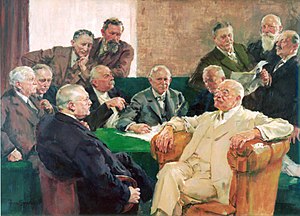Ernst von Simson
Ernst von Simson (born April 7, 1876 in Berlin , † November 7, 1941 in Oxford ) was a German lawyer, diplomat and entrepreneur.
Ernst von Simson was a son of the lawyer August von Simson (1837-1927) and Beate, geb. Jonas, as well as a grandson of Eduard von Simsons . In 1901 he married Martha Oppenheim (1882–1971), a daughter of Franz Oppenheim and great-granddaughter of Martin Wilhelm Oppenheim . The couple had six children, including Dorothea von Simson (1910-1998), who married the lawyer Erckhinger von Schwerin , the art historian Otto von Simson (1912-1993) and the painter Vita Petersen (1915-2011).
life and work
Ernst von Simson first went through a career in the judicial service up to the state judge and in 1908 switched to the Reich Justice Office , where he rose to the lecturing council. In 1911 he was appointed General Secretary of the Kaiser Wilhelm Society for the Advancement of Science , which was founded in the same year . From 1918 he worked in the newly established Reich Ministry of Economics , from 1919 in the Foreign Office , initially as ministerial director and head of the legal department. In this function Ernst von Simson signed the protocol of the ratification of the Versailles Treaty on January 10, 1920 . In 1921/1922 he was State Secretary in the Foreign Office. He attended the London Conference in 1921 , the Genoa Conference in 1922 and the negotiations that led to the Treaty of Rapallo .
In 1922 Ernst von Simson took temporary retirement and worked from then on for Agfa and IG Farben . One of the mandates that he performed in this context was membership of the Presidium of the Reich Association of German Industry . In November 1929 Ernst von Simson headed the German delegation, which negotiated with the French government - ultimately unsuccessful - about the early return of the Saar area to Germany. In the same year he joined the Society of Friends . From 1928 to 1933 he was a member of the Senate of the Kaiser Wilhelm Society.
In 1937 Ernst von Simson was forced to resign from his offices. The following year he emigrated to Great Britain, where he wrote his unfinished memoirs. Von Simson owned a library of around 4,000 volumes, which was torn apart after his escape. A volume from this library was found in Martin Bormann's private library .

Ernst von Simson died in Oxford in 1941 at the age of 65. A memorial stone in the form of a grave stele commemorates him in the Dahlem cemetery in Berlin. Verses by Achim von Arnim from his unfinished work Die Kronenwächter were chosen as the inscription :
- Then give wings and a hill of sand
- The hill sand in the dear fatherland,
- Give the wings to the parting spirit,
- That he can easily tear himself away from the beautiful world.
The memorial stone is to the left of the grave monument for the early deceased son Martin Eduard von Simson (1909–1928). The limestone relief on the front, created by Theodor Georgii , shows a couple saying goodbye to their son.
literature
- Georg Simson, Singuna von Simson (ed.): Ernst von Simson (1876-1941). Memories , Berlin: Jonas'sche Family Foundation 2009.
- Dieter Neitzert: The office between Versailles and Rapallo. Review by State Secretary Ernst von Simson . In: Vierteljahrshefte für Zeitgeschichte 60, 2012, pp. 443–490.
- Norbert Gross: Ernst von Simson: in the service of Germany: from Versailles to Rapallo (1918–1922) , Karlsruhe: Verlag der Gesellschaft für Kulturhistorischedokumentation 2013 (series of publications by the Legal History Museum Karlsruhe; 28) ISBN 978-3-922596-93-6 .
Web links
- Ernst von Simson in the online version of the files of the Reich Chancellery. Weimar Republic
- Literature by and about Ernst von Simson in the catalog of the German National Library
Individual evidence
- ^ Gravestone in Berlin-Dahlem
- ^ Doris Pfleiderer: Germany and the Youngplan. The role of the Reich government, Reichsbank and economy in the creation of the Young Plan . Diss., University of Stuttgart 2002. p. 260.
- ↑ Charlet Flauaus: The Nazi official and his private library. The books of Reichsleiter Martin Bormann in the Mainz University Library . In: Bibliotheksdienst , Vol. 52, 2018, Issue 6, pp. 455–480, here: pp. 473–474.
- ^ Hans-Jürgen Mende, Debora Paffen: Dahlem cemetery and St. Annen churchyard. A cemetery guide . Edition Luisenstadt, Berlin 2007, ISBN 978-3-936242-11-9 , pp. 46–47.
| personal data | |
|---|---|
| SURNAME | Simson, Ernst von |
| BRIEF DESCRIPTION | German lawyer, diplomat and entrepreneur |
| DATE OF BIRTH | April 7, 1876 |
| PLACE OF BIRTH | Berlin |
| DATE OF DEATH | November 7, 1941 |
| Place of death | Oxford |
